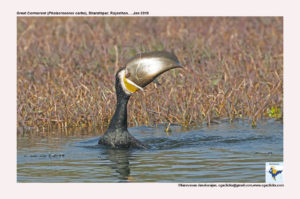Great Cormorant

Great Cormorant Phalacrocorax carbo
Etymology:
- Phalacrocorax : Latin word phalakros – bald-headed ; korax – raven
- Carbo : Latin word for “Charcoal”
Vernacular Names: Sind: Wada silli, Hindi: Ghogur, Paan-kowwa, Jal-kowwa, Sans: Maha jalkak, Kash: Neiar, Pun: Wadda jal kan, Ass: Bor Pani kaori, Cachar: Di dao-Kwa, Ben: Paan-kawri, Guj: Jal kagdo, Moto kajiyo, Mar: Motha pankawla, Kardhok, Te: Bontakaki, Pedda neeti kaki, Mal: Valiya neerakakka
Distribution in India: Winter visitor and passage migrant across India
Description: Size of 80-100 cm. It has during breeding a glossy black overall, with shaggy mane on nape, most of plumage with bluish or sometimes greenish gloss, except for sharply defined white area from throat to ear-coverts, often tinged dull buff or brown, especially on ear-coverts, during courtship has variable number of thin white filoplumes on crown and upper neck, and large white patch on flanks just above thighs; mantle, scapulars and upper wing-coverts have noticeable bronze sheen and even black fringe giving scaled appearance to upperparts when covered by folded wings; tail duller black; during breeding white filoplumes and patch on flanks lost .Non Breeding plumage has a pale area on lower head that becomes less well defined and variably tinged dull brownish so that head looks duller and less contrastingly patterned, nape mane also lost, and black areas duller; iris green; bare facial skin dark greyish over lores and narrowly around eye, being dusky olive to yolk-yellow on gular pouch and at base of mandible, and brightest yellow to orange between gape and eye, entire facial skin more evenly yellow in non-breeding condition, but tends to be duskier yellow on lores with dark central line; bill mostly blackish with some grey mottling on maxilla and tip, pale greyish on most of mandible; legs blackish grey. Sexes similar, but female averages smaller.
Habitat: It is found in lakes, lagoons, reservoirs, wide rivers, salt pans and flood waters. Normally feeds in shallow water. Breeds on inshore islands, cliffs, stacks, amongst boulders and occasionally on wrecked ships and man-made structures
Food Habits: They eat fish, crustaceans and some amphibians. They tend to forage mainly in small loose groups and are often seen foraging alone. This cormorant forages by diving and capturing its prey in its beak.. The bird dives to depths of about 5.8 metres
Breeding Habits: Breeding Season very variable, depending on region, local water conditions and monsoon; Nests on cliff ledges, human edifices, on ground among boulders, on trees, bushes, reed beds or bare ground; nest of sticks, reeds and seaweed, lined with finer material; often reused. Lays a clutch of 3–4 eggs , incubation done by both parents, 27–31 days; fledging in 50 days; post-fledging care is for two months. The chicks attain sexual maturity at 3–5 years.